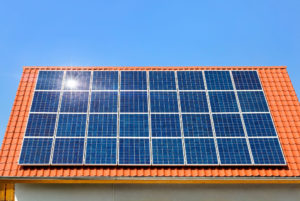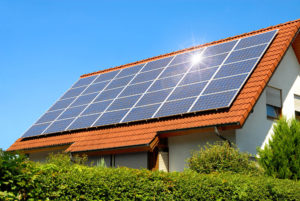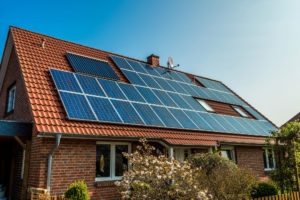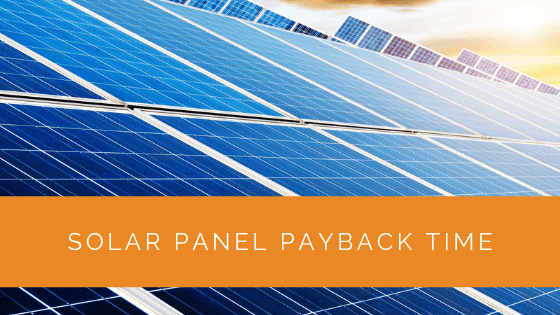Is it true that solar panels pay for themselves? Absolutely! But the question is, when can they start paying for themselves?
A solar panel system is well-known for its environmental benefits. It’s not only a clean source of energy, but it’s also renewable.
Moreover, there is a financially appealing side to it as well. Residential solar panels can boost a user’s property value in several circumstances. Solar battery systems can potentially be used as a return-on-investment source. Solar panel installation, for example, can help consumers save a lot of money on their electricity bills and provide extra energy.
Many solar electricity supporters are intrigued by how long it takes for solar panels to pay for themselves. Suppose you are unfamiliar with how solar panel payback calculations operate. In that case, using the solar panel payback calculator is the best option. On the flip side, read this article to learn a few basics about the solar panel payback system.
But first, let’s start with understanding what the term “solar panel payback” means.
Contents
- 1 Key Takeaways
- 2 What does Solar Panel Payback Mean?
- 3 Payback Period for Solar Panel System
- 4 Factors Impacting Payback Period for Solar Panels
- 5 Factors Affecting the Length of Solar Payback Period
- 6 What is a Reasonable Solar Payback Period?
- 7 Overview of the Solar System Payback Period
- 8 Case Study: Calculating Solar Panel Payback Time for a UK Household
- 9 Expert Insights From Our Solar Panel Installers About Solar Panel Payback Time
- 10 Discover the Power of Solar with Solar Panels Network
Key Takeaways
- Solar panels can eventually pay for themselves by reducing electricity bills and potentially earning incentive payments.
- In the United Kingdom, the payback period for solar panels typically ranges from 5 to 15 years, depending on various factors.
- The payback period is influenced by factors such as the total system cost, electricity usage, solar grants, energy production, additional incentives, and electricity cost, making each installation unique.
What does Solar Panel Payback Mean?
The solar payback period is when you pay for your entire solar panel system. The payment can be made through saving on other electricity bills. People are turning to solar energy due to low-cost equipment and rising electricity costs. So, it’s critical to comprehend the solar payback period from an investment standpoint.
Additionally, comparing quotations from solar installers is a simple way to understand the financial benefits of different solar investment options. It will assist you in determining the break-even point.
It is computed by subtracting the total cost of installation from solar rebates, incentives, and monthly energy bill savings until the total cost is paid off.
Payback Period for Solar Panel System
Your solar panel payback period is the time it takes to save as much on your electricity bills as you paid for your solar panel installed. Consider it a calculator that will help you figure out how long it will take you to break even on your solar power investment.
Note that if you finance your home solar system with solar companies, your “payback period”, or solar panel break-even point, may differ from the time it takes to pay off your system.

Factors Impacting Payback Period for Solar Panels
Total Cost of Solar System
It is easy to figure out how much installing solar panels cost. It’s the cost of installing solar panels without any help from government grants or schemes.
The simplest way to determine how much electricity you use each year is to acquire a year’s energy bills and tally them up each month. If you don’t have access to those invoices, you can use a sample month and extrapolate that home’s average power usage over the year, considering seasonality.
Government Incentives
An incentive is when you receive a discount on your solar system installation, such as a rebate for switching to solar companies. Any money you receive to help pay for your solar panels is money you don’t have to pay back to anyone, which might assist in shortening your solar payback time.
You should also include any savings from schemes, such as when your utility gives you credit for sending excess electricity back into the system. If your solar panels generate more solar energy than you require to power your home, you may send the rest of the energy savings to your electric company. In turn, you can receive a credit that can be used to offset future energy costs.
Your Electricity Bills
The power used in your home significantly impacts how much you spend on monthly electricity bills. It also impacts your electricity bill savings.
The first step in determining your home’s energy costs is determining how much electricity you use. You can multiply by the rate you pay your utility company to see how much money you’ll save. However, it would be best to remember that your electricity cost will almost certainly rise with time.
As a result, you may be able to save even more money in the long term and shorten the time it takes to pay off your solar panels.
Your Solar Electricity Production
Another thing to think about is the efficiency of your solar panel system. Most solar payback period calculations assume that your solar panels will offset 100% of your energy consumption. However, this isn’t always the case. Some systems aren’t designed to offset 100% of your energy use, while others will create more than you require to get net metering credits.
Furthermore, your solar panels renewable energy will gradually lose efficiency over time. That means you won’t save as much money near the end of your useful life because you may still want electricity from your utility. However, for their usual 25-year life, modern solar panels retain around 80% generating efficiency. It is enough to get you to your PV payback period and beyond.

Factors Affecting the Length of Solar Payback Period
Because each solar PV system is tailored to an organisation’s unique energy and financial needs, no two systems are comparable in payback times. The actual payback period is determined by a variety of factors, including:
Energy and Money Used
Installing solar panels or batteries has a relatively short payback period in markets with high utility rates. As a result, the first step in starting your solar PV project is to evaluate your energy bills. It will show you a picture of your energy consumption and spending through multiple utility bills from your supplier.
The Quantity of Clean Electricity Produced
The quantity of electricity your solar PV system provides is offset from what you would typically demand from the grid. It is determined by:
- the size of your PV system,
- the intensity of direct sunlight the site receives,
- and the installation quality (components and workmanship).
As a result, it’s critical to make the most of your available area for a solar PV installation, guaranteeing that you get the most out of the energy production. This does not have to be your rooftop; it might be an undeveloped property or a parking lot.
The Price of the Solar PV System
The installation costs are made up of low-cost equipment and potential solar incentives. Various incentives are available to make renewable energy even more affordable than it is now.
Payment for Solar Panel Installation
Financing your solar PV system using cash upfront or with low-interest loans is the most cost-effective alternative over the system’s lifetime. While some upfront cash is required, this strategy pays for itself over time. It does so by:
- increasing savings and profits,
- allowing you to reinvest in your business
- Take advantage of incentives such as the Smart Export Guarantee (SEG) scheme, turning your system into a new revenue stream.
What is a Reasonable Solar Payback Period?
Solar panels last for about 25 years. Much newer models last even longer. A good payback period can be less than half that time.
Even more important than the payback period is the IRR or the “Internal Rate of Return.” IRR is an indicator of the return on investment. It is important to take into account the future benefits of the investment. It helps you analyse the percentage of return on investment needed from another investment.
IRR in the solar sector helps compare other common investment options with a solar panel investment.

Overview of the Solar System Payback Period
It’s critical to comprehend how and when you’ll receive a return on your solar panel investment. Solar panel installations can save you money in the long run, but you may not realise the full scope of the benefits for some time. The solar payback period is a term used to describe this time frame. Here are the key takeaways from this guide:
- Solar panels start to cover their costs over time by lowering your electric bills. In certain cases, it also earns you money through continuous incentive payments.
- In the United Kingdom, the payback period for solar panels ranges from 5 to 15 years, depending on where you reside.
- The amount you pay, the cost of power from your provider, and the possible beforehand and running incentives all influence how quickly your solar panels pay for themselves.
The amount of time it will take for the savings from your solar thermal to equal the money you paid for them is the payback period. Understanding the relationship between:
- your electricity usage,
- solar grants,
- total system cost,
- energy production,
- additional incentives, and
- the cost of electricity will help you estimate your solar payback.
Unfortunately, there is no one answer for the average solar panel payback period; however, this guide is all you need to get going.
Case Study: Calculating Solar Panel Payback Time for a UK Household
Background
A UK-based homeowner approached Solar Panels Network to install a solar panel system, aiming to reduce their electricity bills and contribute to a greener environment. The client was particularly interested in understanding the payback period to evaluate the financial viability of the investment.
Project Overview
The project involved installing a 4kW solar panel system on the client’s property. The homeowner was concerned about the initial cost and the time it would take for the system to pay for itself through savings on electricity bills. Our goal was to provide a detailed analysis of the expected payback period and the financial benefits over the system’s lifespan.
Implementation
- Property Assessment: Conducted a thorough assessment of the property’s roof space, orientation, and shading to design an optimal solar panel system.
- System Installation: Installed a 4kW solar PV system, including high-efficiency monocrystalline panels, inverters, and a monitoring system.
- Battery Integration: Integrated a solar battery storage system to store excess energy generated during peak sunlight hours.
- Cost Calculation: Calculated the total installation cost, including equipment, labour, and additional components like the battery system.
- Incentive Utilisation: Utilised available government incentives and rebates to reduce the upfront cost.
- Savings Estimation: Estimated annual savings on electricity bills based on historical energy consumption data and the expected energy production of the solar system.
Results
- Cost Savings: The system significantly reduced the homeowner’s reliance on grid electricity, resulting in an estimated annual savings of £600 on electricity bills.
- Payback Period: The payback period for the solar panel system was calculated to be approximately 8 years, considering the total installation cost, energy savings, and government incentives.
- Long-Term Financial Benefits: After reaching the payback period, the system is expected to continue generating free electricity for at least another 17 years, providing substantial long-term savings.
Summary
This case study demonstrates the financial and environmental benefits of investing in a solar panel system. The client’s initial investment was effectively offset by substantial annual savings on electricity bills, with the system paying for itself in around 8 years. The installation not only contributed to reducing the household’s carbon footprint but also provided a reliable source of renewable energy for the long term. This case highlights the importance of careful planning and consideration of factors like government incentives and energy consumption in determining the payback period for solar panels.
Expert Insights From Our Solar Panel Installers About Solar Panel Payback Time
Understanding the payback period for solar panels is crucial for homeowners considering this investment. The time it takes for the panels to pay for themselves can vary significantly depending on several factors, including local electricity rates and available incentives.
Lead Solar Panel Installer
One of the best ways to shorten the payback period is by taking advantage of government incentives and solar rebates. These can drastically reduce the initial cost, making solar panels an even more attractive option for cost savings.
Renewable Energy Consultant
Investing in solar panels is not just about the environmental benefits; it’s also a smart financial decision. With proper maintenance, a solar panel system can continue to save money long after the payback period is reached.
Solar Energy Specialist
Discover the Power of Solar with Solar Panels Network
Are you navigating the world of solar installations? Look no further than Solar Panels Network, the UK’s trusted partner in harnessing the sun’s potential. Our dedication goes beyond just installations; we’re on a mission to transform how homeowners and businesses across the UK perceive and utilise energy. By choosing us, you’re reducing your carbon footprint and making a smart financial move that promises savings for years ahead. Contact us today and embark on your solar journey.
About the Author
Solar Panels Network stands at the forefront of solar energy solutions, driven by a team of seasoned solar engineers and energy consultants. With over decades of experience in delivering high-quality solar installations and maintenance, we are committed to promoting sustainable energy through customer-centric, tailored solutions. Our articles reflect this commitment, crafted collaboratively by experts to provide accurate, up-to-date insights into solar technology, ensuring our readers are well-informed and empowered in their solar energy decisions.

